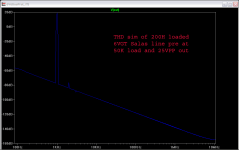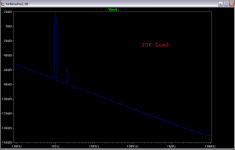The chokes are LL1667 25mA.
Yes Massimo, it is what I had in my drawer!

Those are OK with #26
Happy New Year George!
Those are OK with #26
I had those on my #26 pre, before switching to transformer output with ll1660.
Plot is to set SSHV2 to 20 mA current limit and upping the bias a bit? What LL chokes are that?
My breadboard is on the kitchen table again. Prepping for 1660.
Staffan
I mind LL is the abreviation of Lundhal transformers.
I mind LL is the abreviation of Lundhal transformers.
Spot on Mr Magician
No doubt!I had those on my #26 pre, before switching to transformer output with ll1660.
Let us know how LC load performs vs RC. I'm quite confident it will be better sounding.
I'm very intertested as I have a pair of Iso-Tango anode choke (TC-60-35W) 60H/35mA unused in my drawer that should fill the bill. With a Rdc of 730 ohms what I have to do to try them is to lower the supply voltage to 245-250 to get the same 230-235 V on anode as per the lastest sch.
Unless Salas will recommend some other mods.....
Last edited:
Unless Salas will recommend some other mods.....
Just hold the same bias point, i.e. circa 235V on the plate and 15V on the cathode. The more the inductance the less the THD at more the swing, goes without saying.
Plot is to set SSHV2 to 20 mA current limit and upping the bias a bit?
Staffan
20mA is the preamp's bias current, CCS should be 40mA when using double SSHV2, or 60mA when using common.
20mA is the preamp's bias current, CCS should be 40mA when using double SSHV2, or 60mA when using common.
Ok, that makes sense. Is anyone using single SSHV2? Does it take the current and what happens to the channel separation without finishing with separate LC/RC.
Staffan
It takes >=50K amp to do this FFT. The resistive one holds spec (worse) down to 20K, and the buffer down to 5K. Good luck when making it.
Salas, Could you explain further? Are you saying that this is sim'd performance of this amp with choke and resistor is better or worse. Have considered getting some chokes just to try. Just got new power transformer so will be rebulding it all.
yeap, single reg for 2 channels, takes the current like a champ ...
set to 63mA and 340V output ...
some day I'll try double SSHV2 to see -or better hear- the difference ...
*just visited a friend, I took from him a pair of kenrad 6V6 coke bottle and borrowed 2 tube testers (many 6v6 and 26 tubes to test) ....
its gonna be a funny weekend ...
set to 63mA and 340V output ...
some day I'll try double SSHV2 to see -or better hear- the difference ...
*just visited a friend, I took from him a pair of kenrad 6V6 coke bottle and borrowed 2 tube testers (many 6v6 and 26 tubes to test) ....
its gonna be a funny weekend ...
No doubt!
Let us know how LC load performs vs RC. I'm quite confident it will be better sounding.

I am going to try with LC first. If I don' t like the result maybe try with RC, but I don' t think so.
I am going to try with LC first. If I don' t like the result maybe try with RC, but I don' t think so.
Just a suggestion to avoid confusion. L is induction, R is resistance. LC and RC is low-pass circuits consisting an inductive resp. resistive load in series with a capacistance parallelled to ground, in audio concepts often used in filters, like smoothing B+ or i speaker filters to cut high frequences. Rp is tubes inner resistance, Ra is anode load. If La is a common term I dont know but it would make analogue sence? Or what shorts do you prefere guys? Bermuda? Just watched swede juniors loose the hockeyfinals against USA. Cheers!
Staffan
Salas, Could you explain further? Are you saying that this is sim'd performance of this amp with choke and resistor is better or worse. Have considered getting some chokes just to try. Just got new power transformer so will be rebulding it all.
Choke is better and it needs lighter amp load to maintain all the goodness in this instance. Not that it is a complete slouch at 20K output load, but see the difference to 50K that I had posted before in #1348.
Attachments
Buzz, Salas is speaking in tounges here as you notice. Every constructor will. That is becaus how your eventual preamp will work is 100 % dependent of your load, ie the poweramp or whatever.
Sum shorts: By every anode loaded preamp you test it will sound completely, and I mean compleatly different, against your load, ie the power amp.
Some anode loaded preamps will just fail, or go out of band if you load it to heavily.
The safest preamps (the best imo) doesnt care about the load. That is cathode followers or XXX:x anode loaded OPT preamps.
To many times I have heard people say "This is my preamp" and when they come home it sux.
CFs is hard to construct, very demanding and OPTs are expensive thats why.
Salas products are the best, no kidding, the very best. But you have to take the context in abbreviation.
Staffan
Sum shorts: By every anode loaded preamp you test it will sound completely, and I mean compleatly different, against your load, ie the power amp.
Some anode loaded preamps will just fail, or go out of band if you load it to heavily.
The safest preamps (the best imo) doesnt care about the load. That is cathode followers or XXX:x anode loaded OPT preamps.
To many times I have heard people say "This is my preamp" and when they come home it sux.
CFs is hard to construct, very demanding and OPTs are expensive thats why.
Salas products are the best, no kidding, the very best. But you have to take the context in abbreviation.
Staffan
'xample of moderately decent CF ( all kudos to late AW , and boyz from Tek & HP)
http://www.diyaudio.com/forums/solid-state/225237-germanium-amp.html#post3276988
third (right) pic
http://www.diyaudio.com/forums/solid-state/225237-germanium-amp.html#post3276988
third (right) pic
Last edited:
'xample of moderately decent CF ( all kudos to late AW , and boyz from Tek & HP)
http://www.diyaudio.com/forums/solid-state/225237-germanium-amp.html#post3276988
third (right) pic
Yes ZM, im sure you could land any triode into a decent CF with enough steering. I think you could do it without sand tho, you just have to use the penthodes capabilitys. In laboration...
- Home
- Amplifiers
- Tubes / Valves
- 6V6 line preamp

